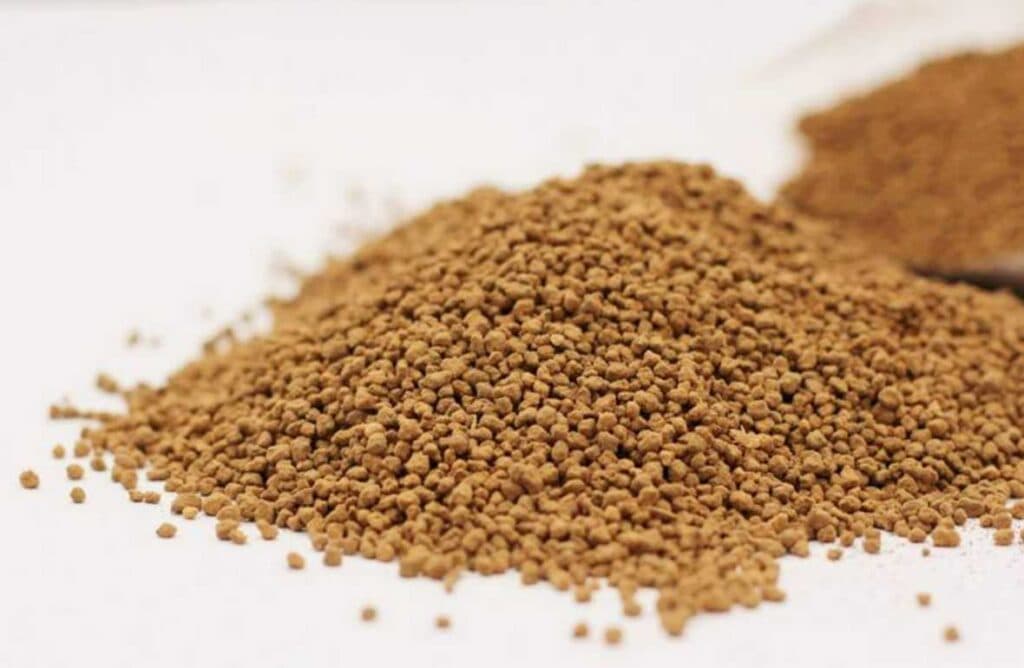What is the principle of compound fertilizer granulation?
Compound fertilizer requires that the powder fineness of each basic fertilizer (nitrogen, phosphorus, potassium, trace elements) and additives and fillers is basically the same. On the basis of uniform mixing, steam and water, or simple fertilizer aqueous solution, Or the spray volume and physical and chemical degree of the binder solution are used to control the granulation process. Granulation in the granulator has three processes: bonding, coating and rolling extrusion.
The process of granular fertilizer pellet bonding
- It is the solution that sticks the powdery materials together into granules. The particles are not smooth and have edges and corners, and sometimes the tiny particles in the particles are visible to the naked eye. The coating process is to coat the particles layer by layer on the particle core, which looks like onion-structured particles. The particles have smooth surface, fine structure and high strength.
- The rolling extrusion process here refers to the rolling extrusion of the material bed, which continuously grinds away the edges and corners of the particles, making the particle structure more dense. In the granulation of compound fertilizer by the aggregation method, the three processes of bonding, coating, and rolling extrusion exist simultaneously. When the operation is good, the “granulation” should be dominated by the process of coating and rolling extrusion, accompanied by bonding. process of action.
Moisture control requirements for compound fertilizer granulation

- When the optimal granulation conditions are achieved for each mixed material system, there is an optimal liquid phase percentage.
- The so-called liquid phase amount refers to the total amount of water plus salts dissolved in water.
- Since the solubility of fertilizer salts in water increases with temperature, for a given compound fertilizer, the higher the granulation temperature, the less water is required.
- Therefore, thermal granulation can be carried out at relatively low moisture content.
- If the raw materials in the ingredients bring in a lot of moisture, plus the dissolved salts, so that the total liquid phase in the mixture far exceeds the need, drying the raw materials or hot return materials (dried and screened fine powder materials) can be used To reduce or adjust the liquid phase of the mixed material.
- Generally speaking, the total liquid content of the entire granulation bed material in the dry powder pellet method must be controlled at 10% to 15%.
- The water and steam, or elemental fertilizer aqueous solution, or binder solution, or pharmaceutical solution added during the granulation process must be sprayed into a mist. The higher the degree of “atomization”, the more the granulation process will be dominated by “coating, rolling and extrusion” under the optimal liquid content of the material.
Drying requirements after compound fertilizer granulation
- During the drying process of compound fertilizer, the material temperature is usually controlled at 70 to 80°C. Excessive temperature will cause nitrogen loss caused by the decomposition of ammonium nitrate, ammonium chloride, ammonium phosphate, and urea, as well as the “degradation” of water-soluble P2O5 and citrus-soluble P2O5 of ordinary calcium, heavy calcium, and ammonium phosphate.
- Drying of compound fertilizers based on urea will release ammonia and form biuret.2(NH2)2CO=NH2CONHCONH2+NH3
- During the production process of compound fertilizer, the more thoroughly it is dried, the less likely it is to agglomerate. Generally speaking, the moisture content of compound fertilizer products containing ammonium nitrate and urea should be less than 1%.
- During the production process of compound fertilizer, granulation and drying must maintain a relatively stable and balanced system water balance, heat balance and particle size distribution of solid materials.
What is the indicator that the particle size distribution of compound fertilizer granulation is in a relatively stable balance?
- Assume that the production capacity of the system is 5t/h, the amount of returned material is 0.08 times the amount of finished product, equal to 0.4t/h, qualified particles account for 10% of the returned material, equal to 0.04t/h, and fine powder and fine particles account for 90%. Equal to 0.36t/h.
- At this time, the amount of material at the outlet of the dryer is about 5.4t/h, of which the amount of qualified particles should be 5.04t/h, accounting for 93.33% of the total. The amount of fine powder, fine particles plus overly coarse and unqualified large particles should be is 0.36t/h, accounting for 6.67% of the total. In this case, only 0.04t/h of qualified particles and 0.36t/h of fine powder and fine particles can still be maintained in the 0.4t/h return material of the next cycle. grain.
- If the system can always be in this situation, the solid material particle distribution of the system can be maintained at a stable balance. Due to fluctuations in operating conditions, operating levels and other factors, the balance of solid material particle size in the system will often change, but this may be balanced for a long period of time (such as an hour).
- If the screened compound fertilizer is packed in bags or stored in bulk without being fully cooled, it will cause damage to the packaging materials or agglomeration of the compound fertilizer product. Generally speaking, if the temperature of the compound fertilizer product coming out of the cooling device is less than 54°C, it will have better storage performance in stacking or bagging.
- When transporting and storing compound fertilizers, care should be taken not to expose them to rain or sunlight. Rain will cause the compound fertilizer to dissolve, agglomerate and be lost; exposure to the sun will cause the compound fertilizer to lose certain functions or the nitrogen will be lost due to thermal decomposition. For example, the “residual magnetism” function of the NC series multi-component magnetic compound fertilizer gradually decreases as the temperature increases.
- The fewer fine powders or particles contained in the compound fertilizer product, the better. This can reduce the number of contact points between particles or the specific surface area exposed to the atmosphere, reduce the hygroscopic agglomeration of the product, and facilitate storage and transportation.
Raw material characteristics of compound fertilizers granulation process
- The nitrogen raw materials used in compound fertilizers include: urea; ammonium sulfate; ammonium bicarbonate, ammonium chloride, ammonium nitrate, monoammonium phosphate, diammonium phosphate, nitric acid phosphate fertilizer, etc.
- Phosphorus used in compound fertilizers include: ordinary calcium, heavy calcium, calcium magnesium phosphate fertilizer, monoammonium phosphate, diammonium phosphate, nitric acid phosphate fertilizer, etc.
- The potassium used in compound fertilizers includes: potassium sulfate, potassium chloride, etc.
- Potassium chloride has a molecular formula of KCl, a molecular weight of 74.55, and a theoretical K20 content of 63.17%. The pure product is a colorless crystal with a density of 1987kg/m3 at 20°C, a melting point of 790°C, a boiling point of 1413°C, and a Mohs hardness of 2 to 2.5. Slightly hygroscopic, its critical relative humidity decreases with increasing temperature.
- Potassium chloride is easily soluble in water, and the aqueous solution is neutral; the solubility between 0 and 150°C can be obtained by using the following relationship: KCl g/1000g water = 282.7+3.097t+3.037×10-3t2 where t is the temperature, C , the relative error is about 1%.
- Potassium sulfate has a molecular formula of K2SO4, a molecular weight of 174.27, and a theoretical K20 content of 54.06%. Colorless crystal, density is 2662kg/m3 (20℃), melting point is 1069℃, boiling point is >2000℃, has very little hygroscopicity and is not easy to agglomerate. Some crops that are resistant to chlorine, such as tobacco, castor, buckwheat, potatoes, tea, etc., can only use potassium sulfate, potassium nitrate, or potassium phosphate to provide potassium.
Compound fertilizer raw granulation composition and compatibility

The composition of compound fertilizers involves issues such as whether at least two simple chemical fertilizers and medium and trace element fertilizers can be mixed, how to mix them, and the mutual influence between the compatibility. It is generally required that the chemical reaction that occurs during mixing can improve the quality of the mixture.
If the mixture remains stable, its physical properties (caking, hygroscopicity, etc.) should not be affected. However, in some cases the chemical reactions that occur can deteriorate the quality of a single component, such as reducing the solubility of phosphorus (degradation) or decomposing nitrogen compounds to release nitrogen oxides.
Fertilizers that “degrade” or deteriorate their physical properties when mixed are “non-mixable.” Some fertilizers are “low mixability” or “limited mixability”. When mixed, its physical properties will undergo adverse changes, with obvious agglomeration and agglomeration. Generally, these fertilizers can only be mixed before being temporarily applied to the soil, or the compatibility ratio must be appropriate. They may also be “mixable”. Other fertilizers, contrary to the above, are “mixable”. The physical properties of these fertilizer-compatible mixtures remain unchanged and sometimes improved.
Compatibility of nitrogen, phosphorus and potassium elements in granulation
- In order to illustrate whether various fertilizers containing nitrogen, phosphorus, and potassium elements are miscible and to guide reasonable batching, various blending diagrams are drawn based on inferences or experiments based on the physical and chemical basis of compound fertilizers.
- However, the research conclusions on the mixability of various fertilizers are drawn under certain conditions. If the calcium chloride is pre-treated and a certain admixture is added, and the ingredients are granulated to make a compound fertilizer, the physical properties of the fertilizer can be significantly improved.
- Therefore, the two fertilizers of urea and calcium chloride, which were originally considered to be non-miscible, can become limited miscible or miscible. Therefore, fertilizer compounding diagrams are not static and cannot be copied mechanically. They only have guidance or reference value under certain conditions.
Compatibility of nitrogen, phosphorus, potassium elements with other nutrients
- In order to rationally and fully utilize limited resources, countries around the world continue to carry out “agrochemical services”, that is, “formulated fertilization” based on the fertilizer supply capacity of the soil, that is, adding whatever nutrients are needed for crop growth and growth, and as much as is needed. Add as much as you need; supplement whatever nutrients the soil lacks, and use the method of fertilizing to make up for the lack of nutrients.
- For this reason, special compound fertilizers, organic and inorganic compound fertilizers, medicated fertilizers, etc. have emerged and continue to meet market demand. Appropriate amounts of trace element compounds, organic compounds and pesticides are often added to compound fertilizers, which involves their compatibility with nitrogen, phosphorus and potassium.
- When the supply of trace elements in the soil is poor, plant growth will be poor, yields will be reduced, and product quality will decline. When the deficiency is severe, it can lead to loss of production and harvest. If the supply of trace elements is excessive, fertilizer may not only be wasted, but the yield may also decrease.
- Especially when excessive, it will cause poison to plants and even cause special symptoms of poisoning. In severe cases, it will cause plant death. Therefore, the amount of trace elements added to the compound fertilizer should be controlled so that the sum of the compound fertilizer content in the applied unit of soil and the amount that the soil can absorb for plants is within a certain range.
- There are two types of interactions between nutritional elements: one is synergistic effect—the combined physiological effect of two or more elements is less than the sum of their individual physiological effects; the other is promotion or synergy or complementary effect— —The combined physiological effect of two or more elements is greater than the sum of their individual physiological effects.

